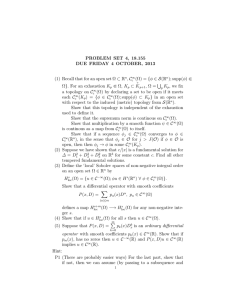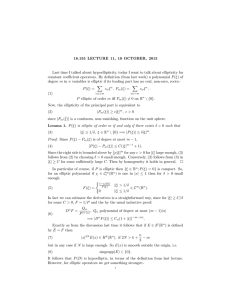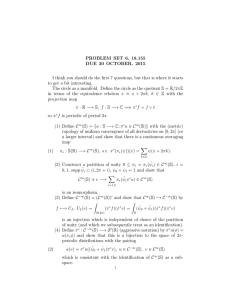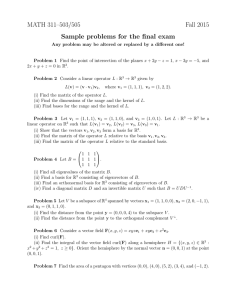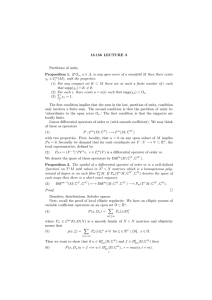18.156 – GRADUATE ANALYSIS ELLIPTIC REGULARITY AND SCATTERING Brief lecture notes
advertisement
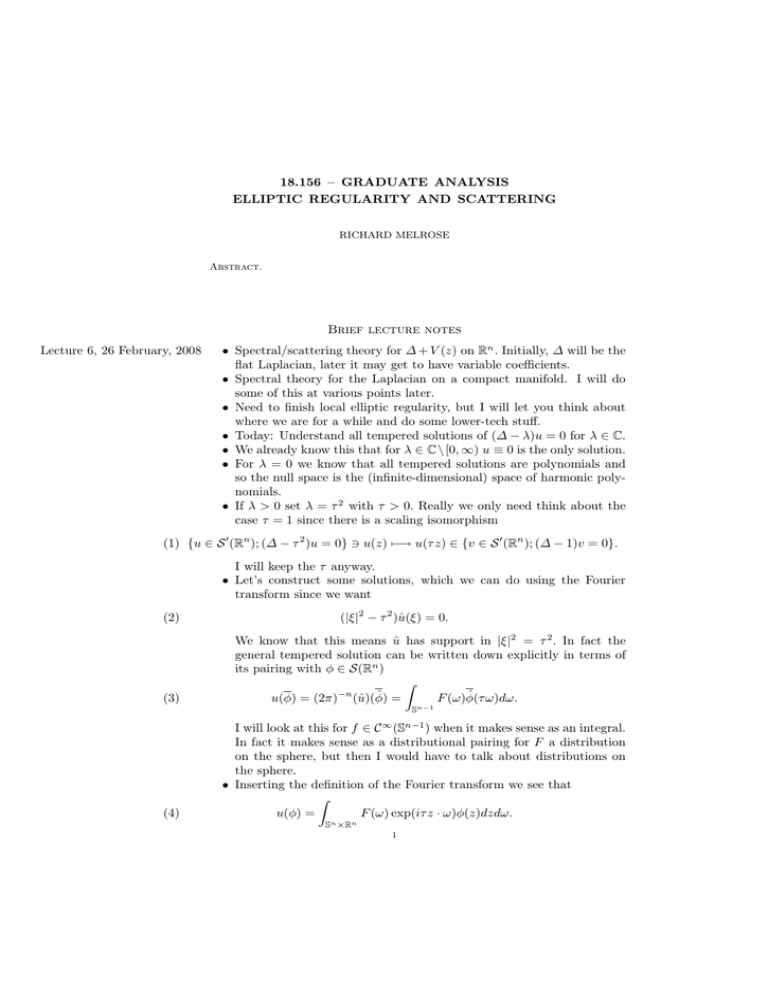
18.156 – GRADUATE ANALYSIS
ELLIPTIC REGULARITY AND SCATTERING
RICHARD MELROSE
Abstract.
Brief lecture notes
Lecture 6, 26 February, 2008
• Spectral/scattering theory for ∆ + V (z) on Rn . Initially, ∆ will be the
flat Laplacian, later it may get to have variable coefficients.
• Spectral theory for the Laplacian on a compact manifold. I will do
some of this at various points later.
• Need to finish local elliptic regularity, but I will let you think about
where we are for a while and do some lower-tech stuff.
• Today: Understand all tempered solutions of (∆ − λ)u = 0 for λ ∈ C.
• We already know this that for λ ∈ C \ [0, ∞) u ≡ 0 is the only solution.
• For λ = 0 we know that all tempered solutions are polynomials and
so the null space is the (infinite-dimensional) space of harmonic polynomials.
• If λ > 0 set λ = τ 2 with τ > 0. Really we only need think about the
case τ = 1 since there is a scaling isomorphism
(1) {u ∈ S 0 (Rn ); (∆ − τ 2 )u = 0} 3 u(z) 7−→ u(τ z) ∈ {v ∈ S 0 (Rn ); (∆ − 1)v = 0}.
I will keep the τ anyway.
• Let’s construct some solutions, which we can do using the Fourier
transform since we want
(2)
(3)
(|ξ|2 − τ 2 )û(ξ) = 0.
We know that this means û has support in |ξ|2 = τ 2 . In fact the
general tempered solution can be written down explicitly in terms of
its pairing with φ ∈ S(Rn )
Z
u(φ) = (2π)−n (û)(φ̂) =
F (ω)φ̂(τ ω)dω.
Sn−1
(4)
I will look at this for f ∈ C ∞ (Sn−1 ) when it makes sense as an integral.
In fact it makes sense as a distributional pairing for F a distribution
on the sphere, but then I would have to talk about distributions on
the sphere.
• Inserting the definition of the Fourier transform we see that
Z
u(φ) =
F (ω) exp(iτ z · ω)φ(z)dzdω.
Sn ×Rn
1
2
(5)
RICHARD MELROSE
This shows something we already know, that u ∈ C ∞ (Rn ) and gives
the integral formula
Z
u(z) =
F (ω)eiτ z·ω dω.
Sn−1
(6)
• What I want to talk about today, is the asymptotic behaviour of u(z)
as |z| → ∞. Let’s fix a direction and set z = Rθ, θ ∈ Sn−1 and look at
Z
u(Rθ) =
F (ω)eiRτ θ·ω dω.
Sn−1
(7)
• In fact it is clear that if we rotate θ, sending it to Oθ for an orthogonal
transformation O then Oθ · ω = θ · O−1 θ so setting ω 0 = O−1 ω,
Z
0
u(ROθ) =
F (Oω 0 )eiRτ θ·ω dω 0
Sn−1
(8)
we see that the effect is the same as rotating F. Since F was arbitrary
anyway, we may as well set θ = (1, 0, . . . , 0) and worry about the
general case afterwards. Thus
Z
u(R, 0, . . . , 0) =
F (ω)eiRτ ω1 dω.
Sn−1
• We can use a partition of unity to decompose F into pieces with small
support. First note that if supp(F ) ∩ ±(1, 0, . . . , 0) then u(R, 0, . . . , 0)
is rapidly decreasing as R → ∞. Change variables and use the Fourier
transform.
• If F has support near either ±(1, 0, . . . , 0) then we can introduce n − 1
local coordinates on the sphere such that
(9)
2
ω1 = ±(1 ∓ (y12 + · · · + yn−1
)).
This allows us to evaluate the integral in the sense that (8) implies
that
1
1
(10) u(R, 0, . . . , 0) = eiRτ R−(n−1)/2 G+ ( )+e−iRτ R−(n−1)/2 G− ( ), as R → ∞
R
R
where G± (x) =∈ C ∞ ([0, 1)) and
(11)
±
G± (0) = c±
n F (±(1, 0, . . . , 0)), cn = .
• Thus we can see what these solutions look like in general using our
ability to rotate the angle θ :
(12)
1
1
, θ) + e−iRτ R−(n−1)/2 G− ( , θ), as R → ∞,
R
R
G± ∈ C ∞ ([0, 1) × Sn−1 ), G± (0, θ) = c±
n F (±θ).
u(Rθ) = eiRτ R−(n−1)/2 G+ (
Lecture 4, 14 Feb Parametrices in open sets.
(a) For a constant coefficient elliptic operator P (D) and Ω ⊂ Rn we want
to construct a parametrix, a continuous linear operator
(13)
QΩ : C −∞ (Ω) −→ C −∞ (Ω) s.t. P (D)QΩ = Id −RΩ
where RΩ is a smoothing operator.
(b) Smoothing operators and proper supports.
18-156-S08
(c) If Q̂ =
3
1−χ(ξ)
P (ξ)
(14)
where χ ∈ Cc∞ (Rn ) and χ = 1 near any zeros of P, then
Z
QΩ f (z) = µ(z, z 0 )Q(z − z 0 )dz 0
is a parametrix where µ ∈ C ∞ (Ω2 ) has proper support and is equal to
1 in a neighbourhood of the diagonal.
Lecture 3, 12 Feb Local elliptic regularity (constant coefficients).
(a) Finish the proof of (17).
Chains of cutoffs. If Ω ⊂ Rn is open and ψ ∈ Cc∞ (Rn ) has support
in Ω then for any k there is a sequence ψj ∈ Cc∞ (Rn ) where with the
notation ψ = ψ0
(15)
supp(ψj−1 ) ⊂ {p ∈ Ω; ψj (x) = 1 in B(p, ) for > 0} ⊂ supp(ψj ) b Ω.
Lecture 2, 7 Feb Sobolev spaces and ellipticity
• Sobolev spaces recalled – LN (=Lecture notes) ‘Sobolev spaces’ section
of Chapter 1.
• Elliptic constant coefficient operators – LN Chapter 2, §2.
• I ‘proved’ that P (D) of order m defines continuous linear map
s+m
s
P (D) : Hloc
(Ω) −→ Hloc
(Ω).
(16)
Started, but did not finish, the basic elliptic regularity result that
(17)
Lecture 1, 5 Feb
s+m
s
u ∈ C −∞ (Ω), P (D)u ∈ Hloc
(Ω) =⇒ u ∈ Hloc
(Ω).
• What I plan to do in this course:Local elliptic regularity:- If P (z, Dz ) is elliptic with smooth coefficients then P u = f with f smooth implies u is smooth.
Spectral theory of the Laplacian – ∆ on a compact manifold.
Scattering theory.
Wave equation, maybe.
• Precursor:- The Laplacian on Euclidean space and tori.
• On Rn , ∆ − λ is invertible on S 0 (Rn ) and S(Rn ) for λ ∈ C \ [0, ∞).
Recall the Fourier transform.
• For λ > 0 the only solutions have inverse Fourier transform u(ω)δ(r −
1
λ 2 ).
• Eigenvalues of the Laplacian on the torus Tn = Rn /Zn by looking
at periodic functions on Rn . The general case of the Laplacian for a
Riemann metric on a compact manifold is similar!
Problems following Lecture 6 – 26 February, 2008
Problem 1. Prove the Fourier transform formula in one dimensional space that
√
i
iπ
i
F(exp( x2 ) = π exp( ) exp(− ξ 2 ).
2
8
2
(18)
Hint. Observe that exp( 2i x2 ) is bounded and continuous, so is an element of S 0 (R).
Furthermore, for t > 0,
(19)
ut = exp(
i−t 2
i
x ) ∈ S(R), lim t ↓ 0ut = exp( x2 ) in S 0 (R).
2
2
4
RICHARD MELROSE
Thus it suffices to compute the Fourier transform of ut . Now,
Z
i−t 2
ubt (ξ) =
e−ixξ e 2 x dx satisfies
R
(20)
ξ2
d
−1
( + (i − t) ξ)ubt (ξ) = 0 =⇒ ubt (ξ) = c(t) exp((i − t)−1 )
dξ
2
as follows by differentiating under the absolutely convergent integral. Thus it suffices to compute the constant, which is the value at ξ = 0. In fact it is convenient
to consider
Z
2
(21)
f (z) =
e−z2x dx for Re(z) > 0
R
in which region the integral converges absolutely, so f (z) is holomorphic. For z > 0
this is a Gaussian integral so
√
1
(22)
f (z) = πz − 2 ,
for the main branch of the square root. Initially this is true for z > 0 but holds
in Re(z) > 0 by the uniqueness of analytic continuation. Thus in fact c(t) can be
computed as a limit, giving (18) (or something like it).
Comments preceeding and problems following Lecture 4 – 14
February, 2008
Problem 2. Recall at least what the Schwartz kernel theorem is about. The most
general sort of operator we are likely to encounter is a continuous linear map
(23)
A : Cc∞ (Ω) −→ C −∞ (Ω0 )
0
where Ω ⊂ Rn and Ω0 ⊂ Rn are open sets. Make sure you understand that
continuity of A is the statement that for each of compact set K b Ω, and each
φ ∈ Cc∞ (Ω0 ) there exist constants C, k and k 0 such that
(24)
0
0
ψ ∈ Cc∞ (Ω), supp(ψ) ⊂ K =⇒ φA(ψ) ∈ H k (Rn ) and kφA(ψ)kH k0 ≤ CkψkH k .
Of course, k 0 may be very negative and k may be very large positive and both
may go off to infinity, as may C, as K or supp(φ) approach the boundaries of their
respective sets.
Now, what the Schwartz kernel theorem says, is that any such continuous linear
operator corresponds to a unique ‘kernel’ KA ∈ C −∞ (Ω0 × Ω), that is a distribution
0
on this open set in Rn+n in the sense that
Z
(25)
(Au(ψ))(φ) = K(φ ⊗ ψ)“ =00
K(z 0 , z)φ(z 0 )ψ(z)dzdz 0
Ω×Ω0
and conversely each such kernel corresponds to an operator A.
This is important, at least psychologically, since it means that linear operators
are again just distributions, so we do not need to have a separate field of operator
theory (haha, of course there is one and it is BIG). The Schwartz kernel theorem
is not very important practically, since for the operators we are interested in, the
kernel tends to be rather obvious. However, it is certainly the case that we use the
easy direction, and the uniqueness, to construct operators.
The ‘easy’ direction is to show that a kernel K does define an operator A through
(25) and I suggest you see if you can write this down. The uniqueness is also pretty
18-156-S08
5
easy, that this operator A determines K, meaning that two K’s cannot give the
same operator. The existence of K, given that A is continuous as in (24) involves
a bit more work so it is a separate problem.
Problem 3. Suppose that A is a continuous linear operator as in (23) and (24). Fix
ψ ∈ Cc∞ (Ω) and φ ∈ Cc∞ (Ω0 ) and consider the cut-off operator A0 u = φA(ψu). Let
hDis be the operator (on S 0 (Rn )) defined as multiplication of the Fourier transform
by hξis = (1 + |ξ|2 )s/2 . Show that if s is be a large negative integer then
(26)
A00 (u) = hDik A0 hDik : L2 (Rn ) −→ C 0 (Rn )
(meaning it maps L2 into bounded continuous functions and is continuous as an
operator from Hilbert to Banach space, the latter having supremum norm). You
might want to use Sobolev embedding to do this! Then use the Riesz representation
theorem (for L2 ) to show that there is a kernel
0
0
K 00 (z 0 , z) ∈ C 0 (Rn ; L2 (Rn )) ⊂ S 0 (Rn × Rn )
for A00 . Go back and show that this gives a kernel for A0 . Finally try to show that
the uniqueness of the kernels shows that the original A has a kernel.
The following result is used in the construction of a parametrix.
Problem 4. A ‘covered’ partition of unity. Given an open Ω ⊂ Rn we can always
find a partition of unity. That is, a countable collection of functions φj ∈ Cc∞ (Rn )
such that
0 ≤ φj (z) ≤ 1 ∀ j, z ∈ Ω
(27)
If K b Ω then {j; supp φj ∩ K 6= ∅} is finite
X
φj (z) = 1 ∀ z ∈ Ω.
j
Now, show that this can be improved in that we can choose these φj so that in
addition there exist φ0j ∈ Cc∞ (Ω) which also have ‘locally finite supports’ in the
sense of the second condition above, and also satisfy
(28)
φ0j = 1 in a neighbourhood of supp(φj ).
Problems following Lecture 3– 12 February, 2008
Problem 5. Show that the statment for a differential operator with constant coefficients that for any open set Ω
(29)
s+m
s
u ∈ C −∞ (Ω), P (D)u ∈ Hloc
(Ω) =⇒ u ∈ Hloc
(Ω)
actually implies the estimates we used to prove it. Namely if ψ ∈ Cc∞ (Ω) and
φ ∈ Cc∞ (Ω) satisfies φ = 1 in a neighbourhood of supp(ψ) then for each t there
exists constants C, C 0 such that
(30)
kψukH s+m ≤ CkψP (D)ukH s + C 0 kφukH t .
Hints. One good way is to show that (29) implies that P (D) is elliptic (if Ω 6= ∅!)
Use the fact that if P (D) is not elliptic then the principal part vanishes on a radial
line. Try to construct a function which is not in H m (Rn ) but such that P (D)u is
in L2 and work from there. This is not so easy.
6
RICHARD MELROSE
Make sure you recall some of the basic properties of convolution. In particualar that
convolution u ∗ v is always defined for distributions if one of u and v has compact
support, that u ∗ V = v ∗ u and that
(31) P (D)(u ∗ v) = (P (D)u) ∗ v, u ∗ f ∈ C ∞ (Rn ) if u ∈ C ∞ (Rn ), f ∈ Cc−∞ (Rn ).
Problems following Lecture 2 – 7 February, 2008
Problems following Lecture 1 – 5 February, 2008
These problems are intended to help you recall the treatment of the Fourier
transform and Sobolev spaces in 18.155.
Problem 6. Recall and explain the definition of Sobolev spaces on Rn :
n
o
(32)
H s (Rn ) = u ∈ S 0 (Rn ); û ∈ L1loc (Rn ); (1 + |ξ|2 )s/2 û ∈ L2 (Rn ) , s ∈ R.
Here I mean that you should explain why the definition as stated makes sense and
that each H s (Rn ) is a Hilbert space.
Problem 7. Show that S(Rn ) ⊂ H s (Rn ) is dense and that the bilinear map
Z
n
n
(33)
S(R ) × S(R ) 3 (u, v) 7−→
u(z)v(z)dz ∈ C
Rn
extends to a non-degenerate pairing for any s ∈ R, i.e. a continuous bilinear map
(34)
H s (Rn ) × H −s (Rn ) −→ C
which allows H −s (Rn ) to be identified with the dual of H s (Rn ).
Problem 8. Show that if λ ∈ C \ [0, ∞) then ∆ − λ defines an isomorphism
(35)
∆ − λ : H s+2 (Rn ) −→ H s (Rn ) ∀ s ∈ R.
Problem 9. Show, following the idea of a similar proof in class on 5 Feb, that
(36)
1
|Dzα hzi| ≤ Cα hzi1−|α| , hzi = (1 + |z|2 ) 2 .
Problem 10. Show that on R3 , for a certain non-zero constant c,
(37)
∆z |z|−1 = (D12 + D22 + D32 )|z|−1 = cδ(z) in S 0 (R3 ).
Problem 11. Using convolution show that if f ∈ Cc−∞ (R3 ) is a distribution with
compact support (if necessary, remind yourself as to what this means) then
(38)
u = c−1 (|z|−1 ) ∗ f ∈ S(R3 ) satisfies ∆u = f.
How is this consistent with the fact, from class, that ∆ is not an isomorphism on
S 0 (R3 )?
Department of Mathematics, Massachusetts Institute of Technology
E-mail address: rbm@math.mit.edu
